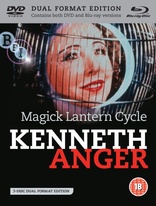
• Fireworks (1947)
• Puce Moment (1949)
• Rabbit's Moon (1950/1971, the rarely seen 16min version)
• Eaux d'Artifice (1953)
• Inauguration of the Pleasure Dome (1954)
• Scorpio Rising (1964)
• Kustom Kar Kommandos (1965)
• Invocation of My Demon Brother (1969)
• Rabbit's Moon (1979 version)
• Lucifer Rising (1981)
Description: Renowned as the author of the scandalous best-selling book Hollywood Babylon, Kenneth Anger is a legend in this own time. The mythology that has grown around him has many sources, from his involvement with the occult, astrology and the pop world of Mick Jagger, Marianne Faithfull and Jimmy Page, to the announcement of his own death in the pages of the Village Voice, and the destruction, loss and banning of his films. At the heart of all this mythology is a filmmaker of prodigious talent, whose skill and imagination create films of great visual force, influencing filmmakers such as Martin Scorsese, David Lynch and RW Fassbinder.
The Films:
Offering a description of himself for the program of a 1966 screening, Kenneth Anger stated his 'lifework' as being Magick and his 'magical weapon' the cinematograph. A follower of Aleister Crowley's teachings, Anger is a high level practitioner of occult magic who regards the projection of his films as ceremonies capable of invoking spiritual forces. Cinema, he claims, is an evil force. Its point is to exert control over people and events and his filmmaking is carried out with precisely that intention.
Whatever one's view of this belief may be, what is undeniable is that in creating the nine films that he either managed to complete (Fireworks [1947], Eaux d'artifice [1953], Inauguration of the Pleasure Dome [1954-66], Scorpio Rising [1963], Invocation of My Demon Brother [1969], Lucifer Rising [1970-81]) or else released as self contained fragments (Puce Moment [1949], Rabbit's Moon [1950-79], Kustom Kar Kommandos [1965]), Anger forged a body of work as dazzlingly poetic in its unique visual intensity as it is narratively innovative. In many ways, these wordless films represent the resurgence and development of the uniquely cinematic qualities widely considered retarded or destroyed by the passing of the silent era, especially in the area of editing. According to Tony Rayns, “Anger has an amazing instinctive grasp of all the elements of filmmaking; his films actively work out much of Eisenstein's theoretical writing about the cinema…. [Anger] comes nearer [to Eisenstein's theories] than anything in commercial cinema and produces film-making as rich in resonance as anything of Eisenstein's own.”
 淘宝店铺:http://94hd.taobao.com
淘宝店铺:http://94hd.taobao.com